Why you can trust Tom's Hardware
Comparison Products
Today, we pit the Viper VPR100 against many of its 2TB competitors. As mainstream competitors, we include the Adata XPG SX8200 Pro, a Samsung 970 EVO Plus, and MyDigitalSSD’s BPX Pro, which features the same hardware components as the Viper VPR100. We also added high-end options such as the 1.5TB Intel Optane SSD 905P, 1TB Samsung 970 PRO, and a 2TB Patriot Viper VP4100, a PCIe 4.0 x4 SSD. To help weigh in on the VPR100’s value, we also included the Intel SSD 660p, a Crucial MX500 SATA SSD, and a 6TB WD Black HDD for good measure.
Game Scene Loading - Final Fantasy XIV
The Final Fantasy XIV StormBlood and Stormbringer are two free real-world game benchmarks that easily and accurately compare game load times without the inaccuracy of using a stopwatch.

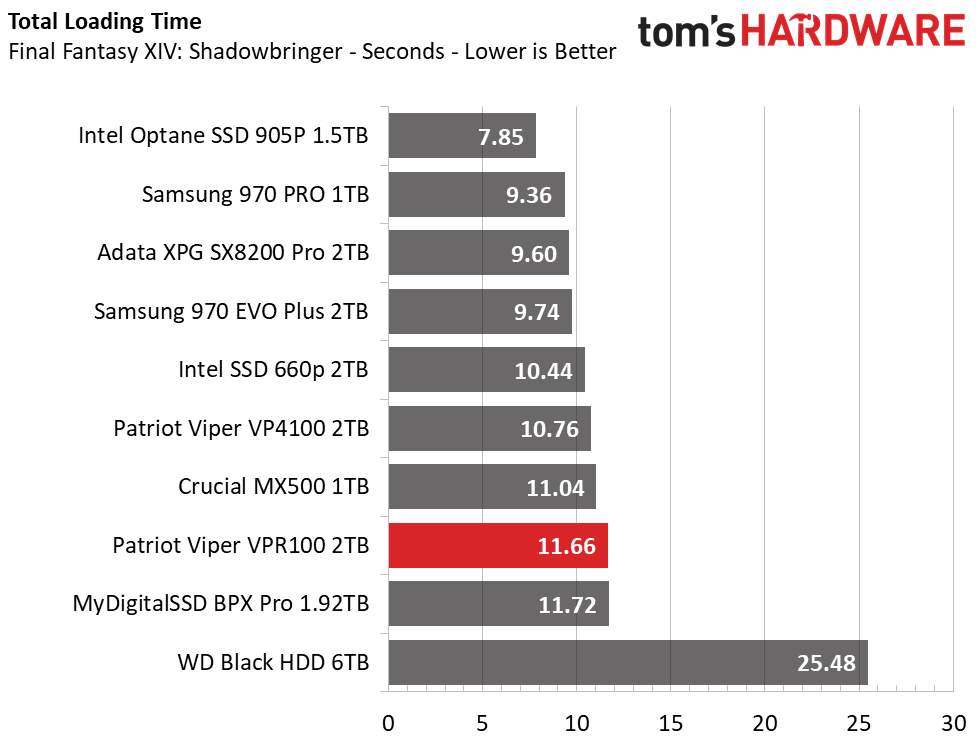
Patriot’s Viper VPR100 matched MyDigitalSSD’s BPX Pro in total load time. Most other SSDs have slightly better 4K performance here, which helps them hit slightly faster load times. But the difference is only a second or two at most.
Transfer Rates – DiskBench
We use the DiskBench storage benchmarking tool to test file transfer performance with our own custom 50GB block of data. Our data set includes 31,227 files of various types, like pictures, PDFs, and videos. We copy the files to a new folder and then follow-up with a reading test of a newly written 6.5 GB file.


Patriot’s Viper VPR100 has lower-than-average file copy performance for a PCIe 3.0 x4 SSD. This is mainly due to the test file folder being larger than the SSD’s write cache. Other SSDs, such as the Samsung 970 EVO Plus or ADATA XPG SX8200 Pro, score similarly to Intel’s Optane SSD 905P. Reading back a large file after the copy, the Viper VPR100 didn’t disappoint, however. When reading large files, it scored fourth place overall, just 1 MBps slower than the MyDigitalSSD BPX Pro. Overall, the Patriot drive delivers much better performance than any SATA SSD and is (of course) significantly faster than any HDD.
Trace Testing – PCMark 10 Storage Tests: Quick and Full
PCMark 10 is a trace-based benchmark that uses a wide-ranging set of real-world traces from popular applications and common tasks to measure the performance of storage devices. The quick benchmark is more relatable to those who use their PCs lightly, while the full benchmark relates more to power users.
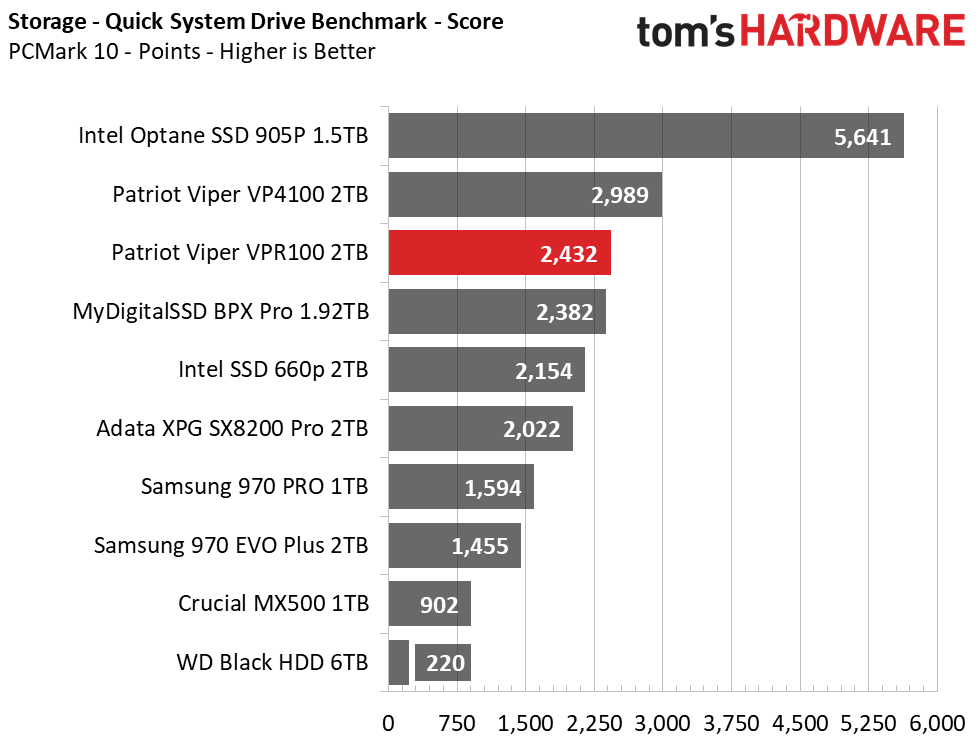
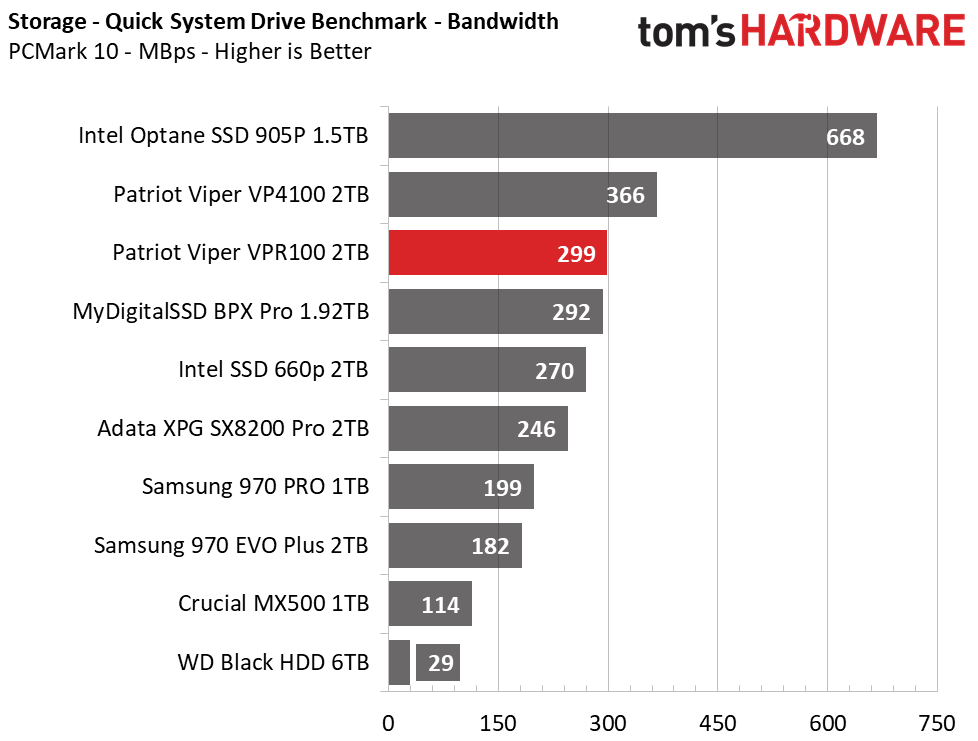
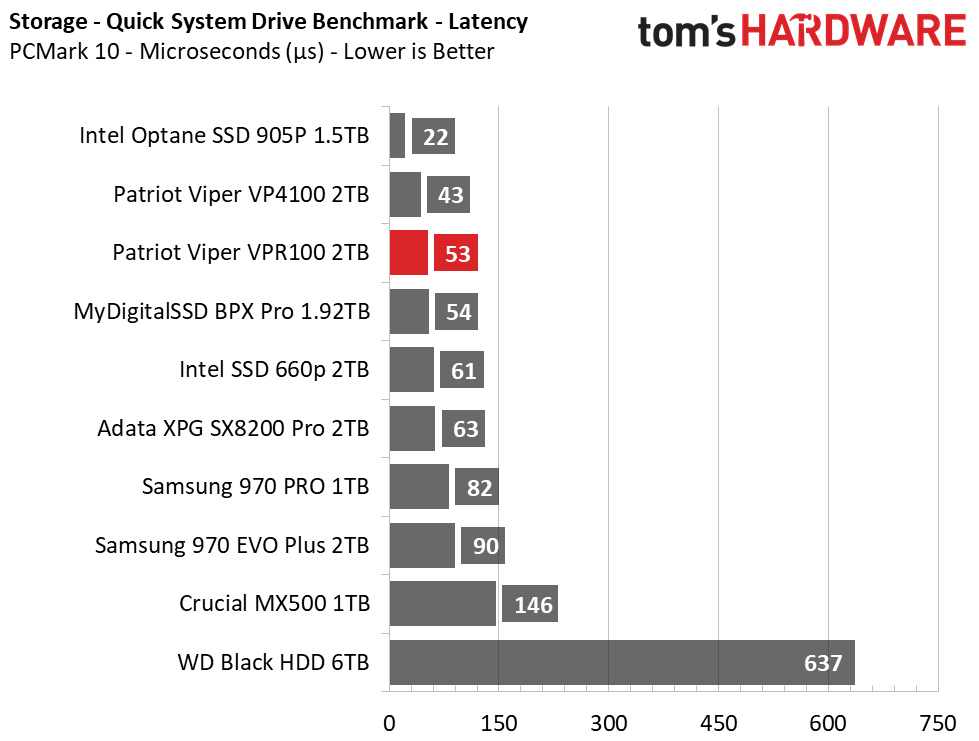
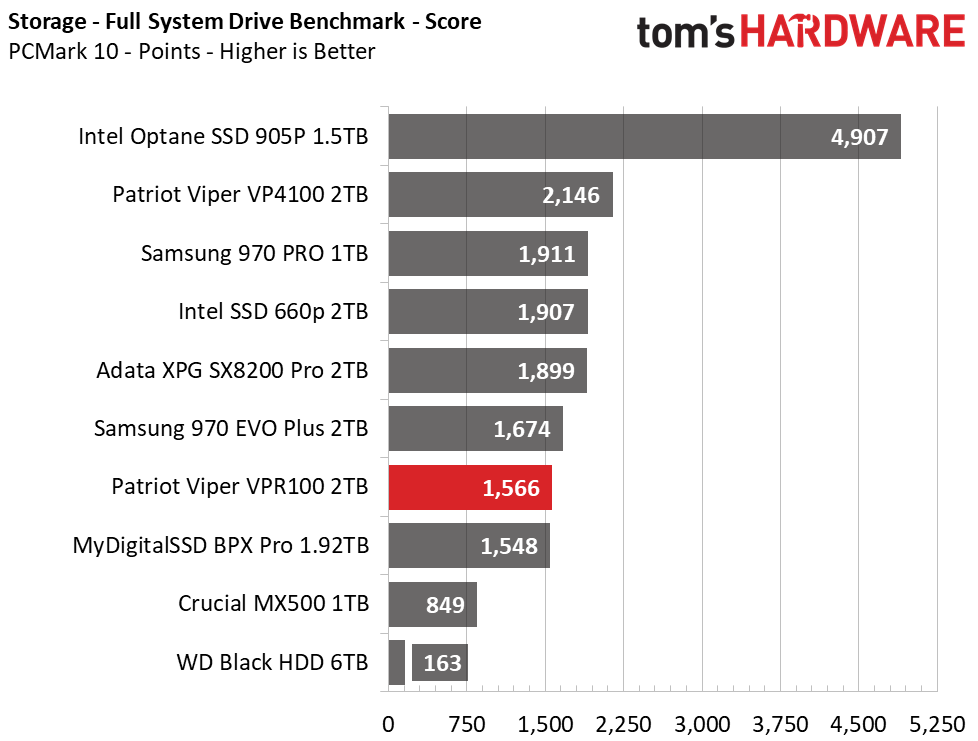


Intel’s Optane 905P can’t be matched if you are looking for lightning-quick response times and the Gen4 interface of the Patriot Viper VP4100 gives it a slight edge over the NAND based competition, even in the full test. But still, the Viper VPR100 doesn't disappoint here.
Get Tom's Hardware's best news and in-depth reviews, straight to your inbox.
In the quick test, Patriot’s Viper VPR100 scored very well, landing in third place, just behind the Viper VP4100 and even beating the Samsung 970 PRO and Adata XPG SX8200 Pro. In the full test, the VPR100 falls behind a bit due to its small write cache, but still provides twice the responsiveness of a SATA SSD and is much more responsive than a mechanical HDD.
Trace Testing – SPECworkstation 3
Like PCMark 8, SPECworkstation 3 is a trace-based benchmark, but it is designed to push the system harder by measuring workstation performance in professional applications.




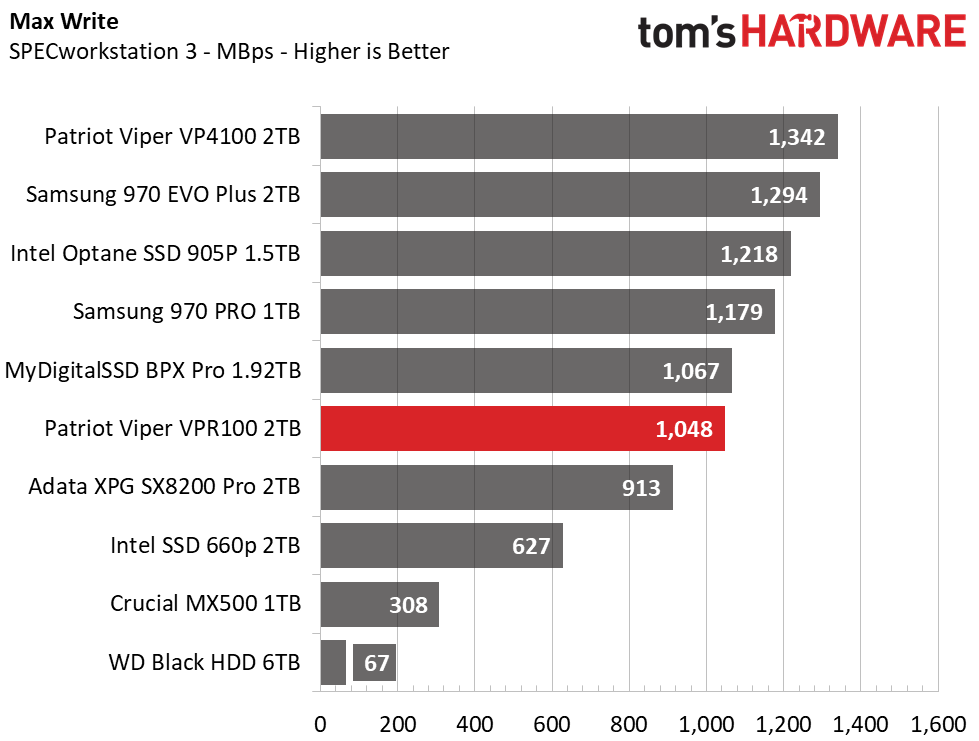
As we have seen in the previous tests, the small write cache affects the Viper VPR100’s ability to sustain performance under heavier workloads. In SPECworkstation 3, the trend continues. Overall, the Viper lands in sixth place, edging out the MyDigitalSSD BPX Pro, but falling behind most mainstream and high-end competitors.
Synthetics - ATTO
ATTO is a simple and free application that SSD vendors commonly use to assign sequential performance specifications to their products. It also gives us insight into how the device handles different file sizes.


In ATTO, we tested Patriot’s Viper VPR100 at a QD of 1, representing most day to day file access at various block sizes. Read and write performance falls in line with most competitors. Read performance peaked at about 3 GBps, or about 11-12x the performance of the WD Black HDD.
Synthetic Testing - iometer
iometer is an advanced and highly configurable storage benchmarking tool that vendors often use to measure the performance of their devices.
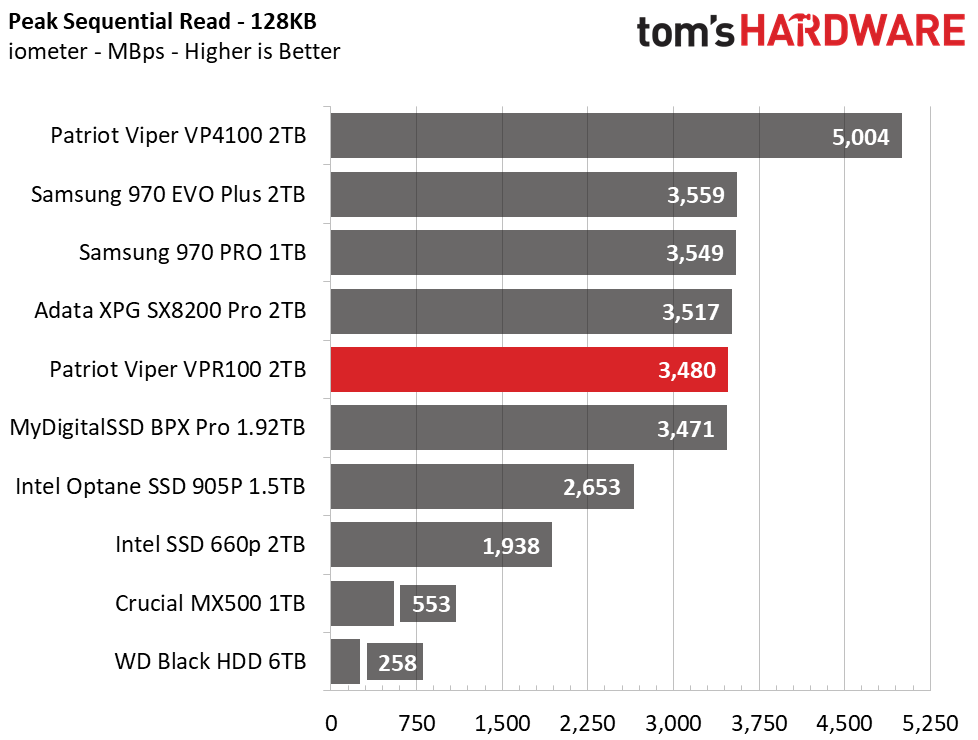


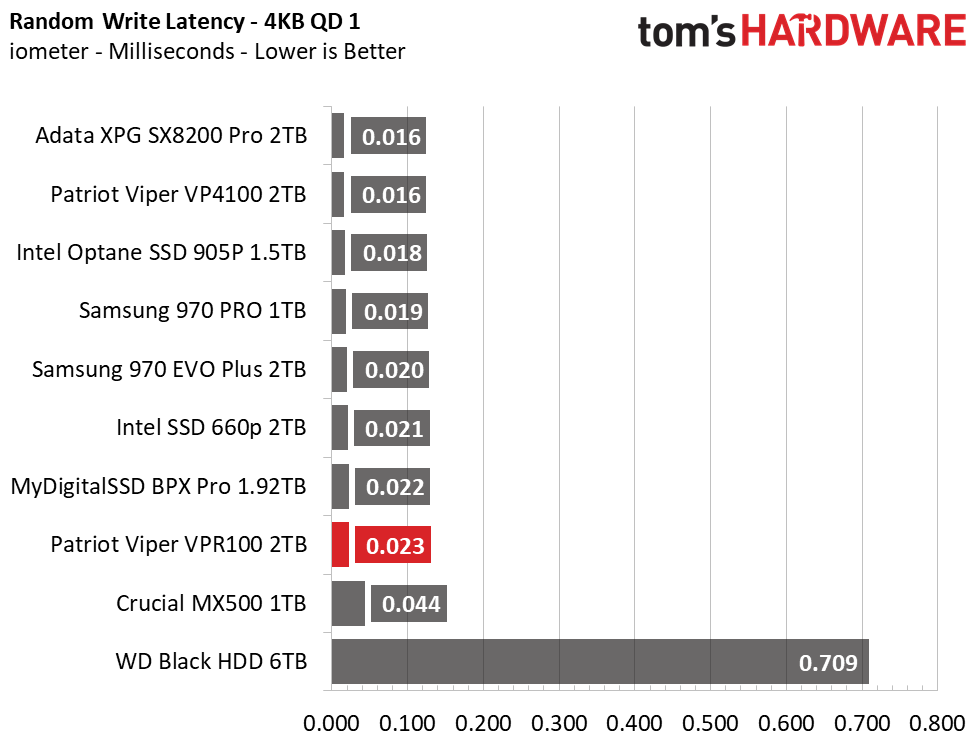




Using iometer, Patriot’s Viper VPR100 established peak sequential performance of 3,480/3,015 MBps read/write, scoring fifth place among our comparison systems. Random performance is responsive, but not quite as responsive as most competitors at a queue depth of 1. Maxing out the SSD with random requests resulted in it hitting 425K/544K IOPS read/write. An HDD simply cannot compare.
Sustained Write Performance, Cache Recovery, and Temperature
Official write specifications are only part of the performance picture. Most SSD makers implement a write cache, which is a fast area of (usually) pseudo-SLC programmed flash that absorbs incoming data. Sustained write speeds can suffer tremendously once the workload spills outside of the cache and into the "native" TLC or QLC flash. We use iometer to hammer the SSD with sequential writes for 15 minutes to measure both the size of the write cache and performance after the cache is saturated. We also monitor cache recovery via multiple idle rounds.
When possible, we also log the temperature of the drive via the S.M.A.R.T. data to see when (or if) thermal throttling kicks in and how it impacts performance. Bear in mind that results will vary based on the workload and ambient air temperature.





The Viper VPR100 can sustain up to 24-25GB of writes at 3 GBps before performance degrades to about 1 GBps. Overall, it nearly matches the BPX Pro with nearly 900GB of data written within 15 minutes. The write cache, while small, recovers within 30 seconds of idle time. So, in most day to day use, it will write at up to 3 GBps without a hitch.
When moving files around, the heat produced by the SSD wasn’t an issue. We first set all LEDs to white and at maximum brightness before we tested temperature. The maximum controller temperature reported was just 72 degrees Celsius during 200-300GB of writing and copying with static air (no airflow) and in a 25C room.
Power Consumption
We use the Quarch HD Programmable Power Module to gain a deeper understanding of power characteristics. Idle power consumption is a very important aspect to consider, especially if you're looking for a new drive for your laptop. Some SSDs can consume watts of power at idle while better-suited ones sip just milliwatts. Average workload power consumption and max consumption are two other aspects of power consumption, but performance-per-watt is more important. A drive might consume more power during any given workload, but accomplishing a task faster allows the drive to drop into an idle state faster, which ultimately saves power.



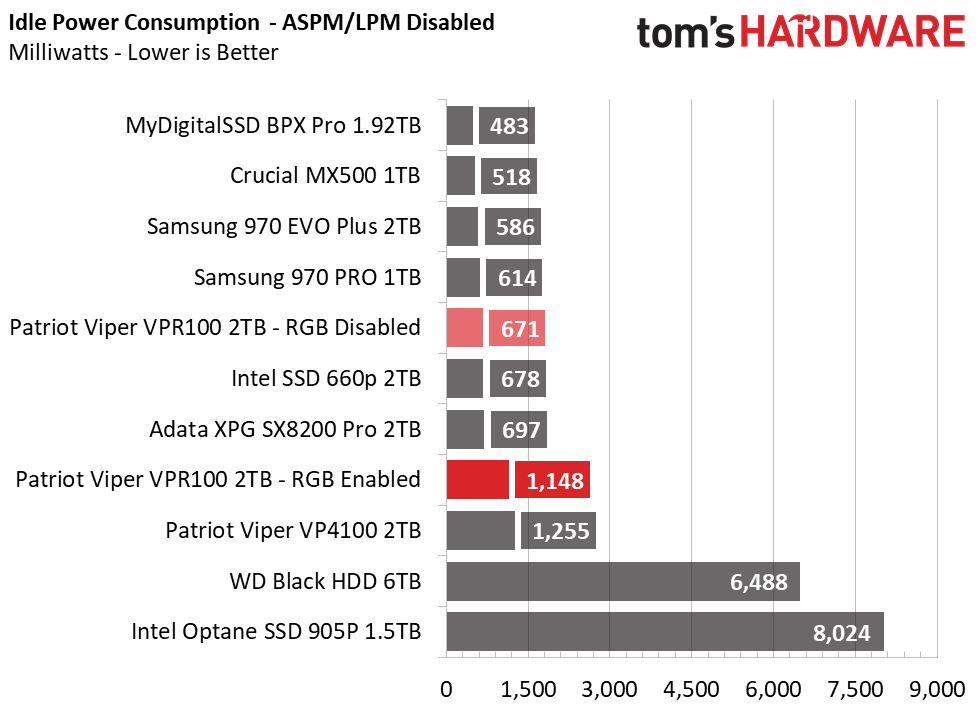

Average and max power consumption is well regulated, but when it comes to power efficiency, Patriot’s Viper VPR100 could use a bit of work. It scores sixth place overall due to its slower-than-average transfer speed during our 50GB copy test. At idle it consumes a bit more power than the competition due to the RGB lighting, which also causes slightly high idle temperatures. But with the lights off, the drive has similar power consumption levels as the rest.
MORE: Best SSDs
MORE: How We Test HDDs And SSDs
MORE: All SSD Content

Sean is a Contributing Editor at Tom’s Hardware US, covering storage hardware.
-
mdd1963 Yes, RGB functionality on my M.2 NVME drives is a MUST!Reply
<extreme exaggerated double eye roll maneuver>! -
King_V I'm just really confused as to the warranty.Reply
The two, hardware-wise, are the same, but one has RGB. They're both rated at the same endurance.
So, why does the non-RGB version have a 3 year warranty, and the RGB version has a 5 year warranty? -
HeavyDutyChainSaw Why is everything RGB these days? Who wants to pimp his rig so badly?Reply
I mean it won't be faster or robuster from the flashy lights. And either you put the case somewhere out of sight (where you don't see it anyway) or it's gonna be distracting having a flashing Christmas tree on your desk beside the displays. I just don't get it...
